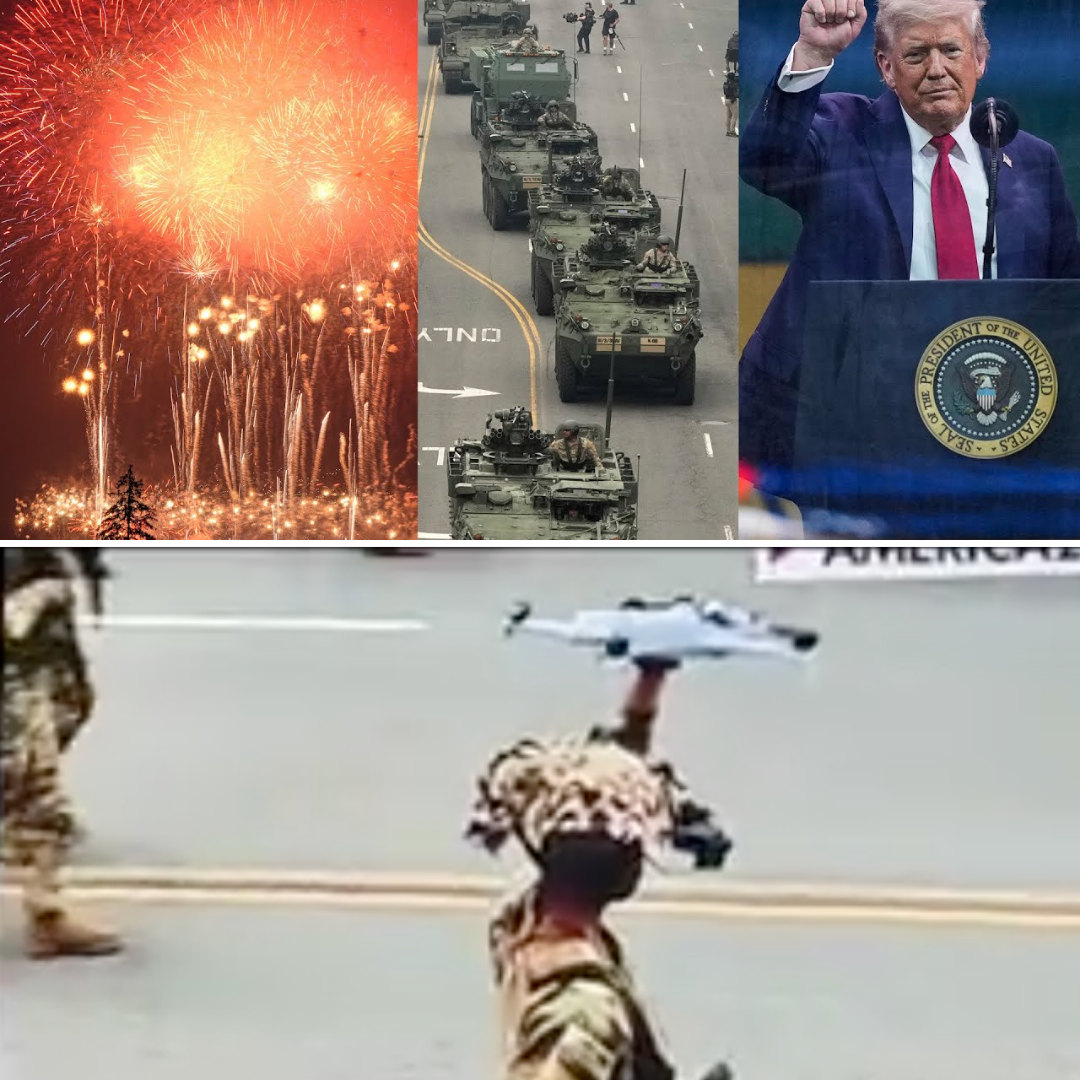Trump’s Parade Just Sparked a FIRESTORM! 😲
Why is everyone talking about the drone soldiers?
Holding drones over their heads?
Critics call it “bizarre” and “dictator-like.”
What’s the real story behind this wild spectacle?
Click to find out! 👇

On June 14, 2025, Washington, D.C., hosted a military parade to commemorate the U.S. Army’s 250th anniversary, an event that coincided with President Donald Trump’s 79th birthday. Featuring 6,600 soldiers, 150 vehicles, 50 aircraft, and futuristic elements like robotic dogs and drones, the parade was billed as a celebration of military heritage. However, it drew sharp criticism, particularly for a segment where soldiers held drones aloft, a display some on X described as “bizarre” and others labeled as authoritarian posturing. Posts on X, such as one from @GaryBut28626677, amplified the backlash, questioning whether soldiers were forced to perform this act and speculating about mockery through “drone engine sounds.” This article examines the parade’s drone soldier controversy, the broader criticisms, and the cultural divide it exposed, drawing on recent reports and critical analysis.
The Parade: A Grand Vision Meets Mixed Reception
The parade, costing an estimated $25–45 million, was a spectacle of military might, with M1 Abrams tanks, Bradley fighting vehicles, and historical reenactors marching down Constitution Avenue. NBC News reported drones and robotic dogs as highlights, symbolizing the Army’s technological future. Trump, joined by First Lady Melania Trump and Defense Secretary Pete Hegseth, saluted troops and delivered an eight-minute speech praising the Army’s “fiercest and bravest” soldiers, avoiding overt political rhetoric. The event included corporate sponsors like Coinbase and Oracle, whose logos flashed on screens, a detail criticized by The New York Times as “unsavory” for potentially leveraging public office for private gain.
Despite its scale, the parade underperformed expectations. The Independent estimated attendance at far below the projected 200,000, with empty bleachers and sparse crowds noted by outlets like The Guardian and Yahoo News. Rainy weather and competing “No Kings” protests, which drew an estimated 4 million nationwide, overshadowed the event. Social media mockery intensified, with videos of soldiers marching out of sync and a viral photo of Trump appearing to doze off, as reported by the Times of India. The drone soldier segment, where troops held drones overhead, became a lightning rod for criticism, symbolizing for some a misstep in tone and intent.
The Drone Soldiers: Symbolism or Stunt?
The inclusion of drone soldiers—troops physically holding drones aloft as they marched—was meant to showcase the Army’s embrace of technology. NBC News described it as part of a segment on the “future of the Army,” alongside robotic dogs. However, the execution drew ridicule. An X post from @GaryBut28626677 claimed a soldier was “forced” to hold a drone and questioned if they mimicked engine sounds, suggesting defiance or absurdity. While the post’s claims about sound effects lack corroboration, the image of soldiers holding drones sparked widespread debate.
Critics on X and Reddit’s r/politics called the display “dystopian” and “dictator-like,” comparing it to North Korean or Russian military parades. The Guardian noted Trump’s long-standing admiration for such spectacles, citing his 2017 awe at France’s Bastille Day parade. Democratic lawmakers, like Senator Adam Schiff, labeled the parade a “vulgar display” that politicized the military, a sentiment echoed by Marine veteran Terry Mahoney, who told Al Jazeera it was “dictator behaviour.” The drone segment, in particular, was seen as a performative flex, clashing with the parade’s stated goal of honoring soldiers.
Supporters, however, saw it differently. Fox News interviewed attendees from Kentucky and Florida who viewed the parade as a tribute to veterans, with one calling Trump a president who “respects our military.” On X, users like @Patriot1776USA defended the drones as a forward-looking nod to innovation, dismissing critics as “woke” detractors. Army spokesperson Steve Warren told The Washington Post the event was a “resounding success,” allowing civilians to interact with soldiers. Yet, the drone soldiers’ odd presentation—lacking the precision of traditional marches—undermined this narrative, fueling perceptions of a disorganized spectacle.
Broader Criticisms: Authoritarianism and Misuse of Funds
The parade’s drone soldiers were just one flashpoint in a broader wave of criticism. Democratic Governor Gavin Newsom called it a “vulgar display,” while protesters with “No Kings” signs accused Trump of authoritarian overreach, per NPR. The timing—amid Trump’s threats to invoke the Insurrection Act and his federalization of 4,000 California National Guard troops against Governor Newsom’s wishes—heightened fears of militarized governance. Al Jazeera quoted critics who saw the parade as “window dressing” for constitutional violations, pointing to Trump’s anti-DEI Pentagon policies and cuts to veterans’ benefits.
The $45 million price tag drew ire, especially given the sparse turnout. A protester told The New Yorker that the funds could have housed D.C.’s homeless, 120 of whom died without shelter in 2024. The corporate sponsorships, including Coinbase and Oracle, raised ethical concerns. Norman Eisen, a former Obama ethics official, told The New York Times the sponsorships risked “abuse of public office for private gain,” given Trump officials’ regulatory ties to these firms. The Washington Post noted federal workers were displaced for three weeks to house soldiers, adding to logistical critiques.
Social media amplified the backlash. The Lincoln Project and user @mollyploofkins.bsky.social shared images of empty stands, while Rolling Stone reported Russian-linked X accounts mocking the parade’s lack of “lockstep” precision compared to North Korea’s. Videos of creaky antique tanks and out-of-sync marching, per the Times of India, led some to speculate about soldier defiance, though no evidence supports claims of intentional sabotage. These elements, combined with the drone soldiers, painted a picture of a parade that aimed for grandeur but landed as “lame,” per The Guardian.
Cultural Divide: A Split-Screen America
The parade and its drone soldiers underscored a divided America, as NPR described in its “split-screen” analysis. On one side, Trump supporters saw a patriotic celebration, with attendees chanting “USA” and singing “Happy Birthday” to the president, per The Independent. On X, pro-Trump users praised the drones as a bold statement of strength, aligning with Trump’s promise to “show off” the military. The parade’s inclusion of historical uniforms and a folded flag presentation—typically reserved for fallen soldiers’ families—resonated with some, though others found the latter tone-deaf.
On the other side, “No Kings” protesters in all 50 states, per NBC News, framed the parade as a dangerous politicization of the military. Signs reading “All hail Commander Bone Spur” mocked Trump’s Vietnam draft exemption, while Reddit’s r/WhiteHouseProtest called the drone soldiers a “creepy” nod to authoritarianism. The contrast between the parade’s heavy metal music and tanks and the passionate protests, per Yahoo News, highlighted two Americas: one embracing military spectacle, the other rejecting it as a betrayal of democratic norms.
The Soldiers’ Perspective: Caught in the Crossfire
The soldiers themselves, including those holding drones, were thrust into a political maelstrom. At Fort Bragg days earlier, some booed Trump’s attacks on political opponents, per The New Yorker, suggesting discomfort with his rhetoric. The X post’s claim of a soldier “forced” to hold a drone reflects a sentiment that troops were used as props, but no reports confirm coercion or defiance like mimicking drone sounds. A soldier quoted by The New Yorker emphasized duty—“Do the mission, then we go home”—indicating a focus on execution over politics.
The out-of-sync marching, mocked by the Times of India, may reflect logistical challenges rather than intentional protest. The parade’s scale, with 6,600 troops and complex elements like drones, likely strained coordination. Still, the drone soldiers’ awkward presentation—holding devices aloft without clear purpose—invited scrutiny, amplifying perceptions of a poorly planned event.
Can the Narrative Shift?
The parade’s fallout, particularly around the drone soldiers, poses challenges for Trump’s administration. The event’s high cost and low turnout, coupled with ethical concerns over sponsorships, have fueled accusations of self-aggrandizement. Build a Rocket Boy’s MindsEye launch, discussed elsewhere, offers a parallel: blaming external “bad actors” (as their CEO did) rarely quells criticism when flaws are evident. Trump’s team claimed 250,000 attendees, per The Independent, but aerial photos and media reports suggest far fewer, undermining their narrative.
Future military events will need careful framing to avoid similar backlash. The drone soldiers, while innovative in concept, misfired in execution, becoming a meme rather than a symbol of progress. For the Army, the parade was a chance to showcase 250 years of service, but its politicized context and logistical hiccups overshadowed that goal. As The Washington Post noted, cleanup crews moved D.C. “back toward normalcy” by June 15, but the cultural rift exposed by the event lingers.
Conclusion: A Misstep in Symbolism
The drone soldiers holding devices over their heads were a small but telling part of a parade that aimed to project strength but stumbled into controversy. Critics saw authoritarianism; supporters saw patriotism. The truth lies in execution: a costly, poorly attended event marred by logistical issues and questionable optics, like corporate logos and awkward drone displays. The soldiers, caught between duty and public scrutiny, became symbols of a divided nation.
The parade’s legacy, like the drones held aloft, is one of unrealized potential. Trump’s vision of military grandeur, inspired by foreign spectacles, clashed with American democratic sensibilities, amplified by protests and social media. As the nation moves forward, the drone soldier image—strange, divisive, and meme-worthy—will endure as a cautionary tale of spectacle over substance.





